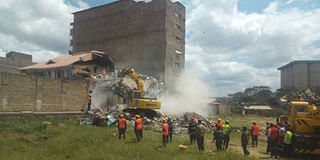Authorities do not care enough about deathtraps called homes

Rescue teams demolish the seven-storey building that collapsed in Kware, Embakasi, in Nairobi on June 12, 2017. PHOTO | LILIAN MUTAVI | NATION MEDIA GROUP
What you need to know:
- Overcrowding, poor ventilation and lack of amenities, such as playgrounds, are common.
- In Nairobi’s slums, an average of six people share a room that has no bathroom or kitchen.
- More than 90 per cent of the people living in the slums have no sanitation to speak of; most share pit latrines with dozens of their neighbours.
When Nairobi residents want to re-paint their houses or apartments or to cut a tree that is dangerously close to a power line, they need the permission of the county to do so.
But when an unscrupulous developer puts up a poorly constructed seven-storey building with no lift (a requirement for buildings that have more than four floors), he can do so with impunity.
In a city where the rich and the poor lead separate – but deeply interconnected – lives, this is not surprising.
Nairobi is really a tale of two cities – one with tarmacked roads, sewage systems, street lighting and shiny buildings and the other with little or no sanitation or paved roads.
STANDARDS
The standards that apply to one part of the city do not apply to the other.
This is why the county government is not particularly concerned about the health and environmental hazards posed by hundreds of pit latrines located the slums, which regularly overflow in the rainy season, but will arrest someone for smoking in a non-designated area in the central business district.
The collapse of a seven-storey building in the Embakasi area and the burning down of a residential tower block in London last week have highlighted how government neglect and double standards put poor people’s lives at risk.
High-rise buildings housing low-income families, such as the ones in London and Embakasi, have been referred to a “vertical ghettos” because, while they are a step up from shacks, they don’t necessarily improve the quality of life of the residents.
POOR VENTILATION
Overcrowding, poor ventilation and lack of amenities, such as playgrounds, are common.
Residents of the London tower block, which was located in one of the richest boroughs, said that despite their repeated complaints to the council about dampness, leaking roofs, rats, cockroaches and other vermin, the authorities failed to respond.
There was no fire escape on the outside of the building either, which meant that residents were literally trapped in their flats when the fire broke out as they could not exit from the windows to escape the inferno.
In 2015 Nairobi Governor Evans Kidero stated that he would inspect and audit all buildings in the city, especially illegal ones in low-income neighbourhoods.
DEMOLISHING BUILDINGS
If the inspections have been carried out, why is it that buildings such as the one in Embakasi were allowed to stand?
What is stopping the county from condemning and demolishing these buildings?
Maybe it is because in cities such as Nairobi, the urban poor are rendered “invisible”, and, therefore, unworthy of attention.
The authorities do not care if poor people – who work in rich people’s homes and offices as domestic workers, janitors, drivers, watchmen and the like – live in a tin shack with no toilet or in a poorly constructed building that is likely to collapse.
Yet these are the people who provide the bulk of Nairobi’s labour.
SHARE A ROOM
In Nairobi’s slums, an average of six people share a room that has no bathroom or kitchen – think of the psychological, social and environmental impact of this.
More than 90 per cent of the people living in the slums have no sanitation to speak of; most share pit latrines with dozens of their neighbours.
In the rainy season, the latrines overflow and water-borne diseases spread.
Slum upgrading programmes have largely failed because they often adopt top-down approaches and also because they threaten the livelihoods of cartels comprising politicians, private developers, local chiefs and landlords.
In recent years, public land has become a sought-after commodity that is allocated at whim to those who are politically connected.
PRIVATE DEVELOPERS
This has allowed avaricious private developers to exploit low-income people’s need for affordable housing, which the public sector is no longer providing.
The issue of public or social housing has been widely debated, but there seems to be no consensus on what is the best way forward.
Many argue that poor countries cannot afford to invest in low-income public housing, and, therefore, it is up to the private sector to fill the gap.
This may be so, but when regulations are regularly flouted by greedy developers, it is imperative that local governments take a more pro-active role in ensuring that such housing is safe and liveable; this includes ensuring that public amenities, such as playgrounds, parks, clinics and schools, are made more accessible to residents.





